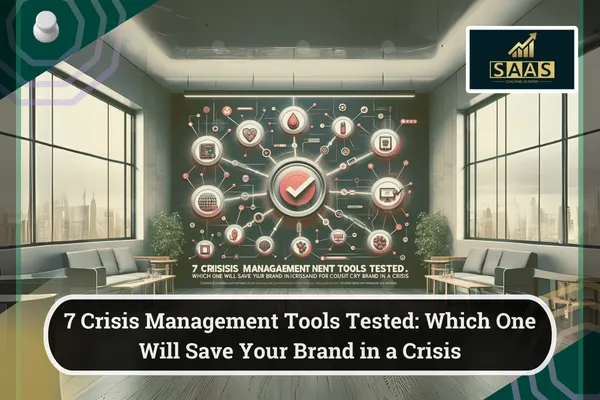Exciting Insights and Tips on Digital Marketing, Sales, Hustle Life, Customer Service, and Upcoming AI

7 Crisis Management Tools Tested: Which One Will Save Your Brand in a Crisis
Introduction to Crisis Management Tools
In today's fast-paced and interconnected world, the importance of crisis management tools cannot be overstated. From social media scandals to product recalls, brands are constantly at risk of facing crises that can tarnish their reputation and erode trust with stakeholders. This is why being prepared and proactive in handling crises is essential for safeguarding a brand's image and maintaining credibility in the eyes of consumers.
The key to effective crisis management lies in having the right tools at your disposal. These tools can help you detect, analyze, and respond to crises in a timely manner, minimizing the damage and ensuring a swift resolution. By being equipped with the right resources, brands can not only weather the storm but also emerge stronger and more resilient in the face of adversity.
In this section, we will delve into the significance of crisis management tools and their role in protecting a brand's reputation during times of turmoil. We will explore the importance of preparedness, proactive communication, and strategic decision-making in crisis management. By setting the stage for the in-depth review of 7 top crisis management tools that will follow, we aim to provide readers with a comprehensive understanding of the tools available to help them navigate through crises effectively.
As we embark on this journey to explore the world of crisis management tools, it is crucial to emphasize the importance of being proactive rather than reactive when it comes to handling crises. By staying ahead of the curve and being prepared for any eventuality, brands can mitigate risks, maintain trust with stakeholders, and emerge stronger from challenging situations.
Join us as we delve into the realm of crisis management tools and discover how these tools can be your trusted allies in safeguarding your brand's reputation and maintaining credibility in the face of adversity. Stay tuned for the detailed review of 7 top crisis management tools that will equip you with the knowledge and resources to navigate through crises with confidence and resilience.

Overview of 7 Crisis Management Tools
As we continue to explore the importance of tone in professional email communication, it is crucial to understand how to navigate the nuances of tone to effectively convey your message. Tailoring your tone based on the context, audience, and purpose of your email is essential in ensuring that your message is received positively and understood clearly.
One key strategy for navigating the nuances of tone is to consider the relationship you have with the recipient. For example, when emailing a colleague or client, it is important to strike a balance between professionalism and friendliness. Using a tone that is too formal may come across as cold or distant, while a tone that is too casual may be perceived as unprofessional. By understanding the dynamics of your relationship with the recipient, you can adjust your tone accordingly to maintain a respectful and engaging communication style.
Another important aspect to consider when navigating the nuances of tone is the context of the email. For example, when addressing a sensitive issue or delivering constructive feedback, it is crucial to adopt a tone that is empathetic and understanding. By acknowledging the recipient's perspective and emotions, you can create a more supportive and collaborative environment for communication.
Furthermore, it is essential to be mindful of the purpose of your email when navigating the nuances of tone. Whether you are requesting information, providing updates, or seeking feedback, adapting your tone to align with the purpose of your message can enhance the clarity and effectiveness of your communication. Using clear and concise language, avoiding jargon or ambiguity, and incorporating emotional intelligence into your emails can help you convey your message in a way that resonates with the recipient.
By implementing these practical tips and strategies for navigating the nuances of tone in email correspondence, you can enhance your communication skills and build stronger relationships with your colleagues, clients, and partners. Mastering the art of tone in professional email communication is not only essential in today's digital age but also a valuable skill that can set you apart as a thoughtful and effective communicator. In the next section, we will delve into key insights for mastering email communication to further enhance your skills and leave a lasting impression on your recipients.

Real-Time Monitoring Tools
Real-time monitoring tools are essential for brands to stay ahead of potential crises and manage their online reputation effectively. These tools provide instant insights into emerging issues and trends, enabling brands to detect and respond to crises swiftly. By monitoring news outlets, social media platforms, and online forums in real-time, brands can proactively address negative narratives and engage with stakeholders to mitigate the impact of crises.
One of the key benefits of real-time monitoring tools is their ability to provide brands with a comprehensive view of the conversations happening around their brand. By analyzing data from various sources, such as social media mentions, news articles, and customer feedback, brands can identify potential crises early on and take proactive measures to address them. This proactive approach not only helps in minimizing the damage caused by crises but also allows brands to maintain trust with stakeholders and protect their reputation.
Different real-time monitoring tools offer a range of features and functionalities to help brands effectively monitor and respond to crises. Some tools provide sentiment analysis to gauge the tone of online conversations, while others offer automated alerts to notify brands of emerging issues. By leveraging these tools, brands can streamline their crisis management processes and ensure timely and effective responses to crises.
In the next section, we will delve into the effectiveness of various real-time monitoring tools in helping brands navigate through crises and maintain a positive image in the eyes of consumers. Stay tuned to learn more about how these tools can be your ally in safeguarding your brand's reputation during times of turmoil.

Choosing the Right Crisis Management Tool for Your Brand
In today's fast-paced digital age, mastering the art of professional email communication is more important than ever. Throughout this blog post, we have explored the significance of tone in emails, how it can impact the effectiveness of your message, and practical strategies for enhancing your communication skills.
By understanding the importance of tone, navigating its nuances, and implementing key insights for mastering email communication, you can elevate your communication skills and leave a lasting impression on your recipients. Remember, the tone you use in your emails can shape how your message is received, influence the recipient's perception of you, and ultimately determine the success of your communication.
As you continue to refine your email communication skills, remember to pay attention to the language and phrasing you use, adapt your tone based on the recipient's preferences, and seek feedback to improve over time. By applying the tips and strategies discussed in this blog post, you can effectively convey your message, build stronger relationships, and achieve successful outcomes in your professional email correspondence.
In conclusion, mastering professional email communication is a continuous learning process that requires practice, dedication, and a thoughtful approach. By incorporating the insights shared in this blog post into your communication style, you can set yourself apart as a thoughtful and effective communicator in today's digital age. Take the time to refine your tone, tailor your message to the context and audience, and always strive for clarity and professionalism in your emails. Remember, the way you communicate matters, and mastering the art of tone in email communication can make all the difference in your professional interactions.


Choosing the Right Crisis Management Tool for Your Brand
In the fast-paced and interconnected world we live in, the importance of crisis management tools cannot be overstated. As we have explored in this blog post, these tools play a crucial role in safeguarding a brand's reputation, maintaining credibility with stakeholders, and navigating through crises effectively. From real-time monitoring tools to social media response strategies, brands have a variety of options to choose from when it comes to crisis management.
When it comes to selecting the right crisis management tool for your brand, there are several key considerations to keep in mind. First and foremost, it is essential to assess your specific needs and requirements. Consider factors such as the size of your organization, the nature of your industry, and the level of risk your brand faces. By understanding your unique circumstances, you can choose a tool that aligns with your goals and objectives.
Budget is another important consideration when selecting a crisis management tool. Evaluate the cost of different tools and weigh it against the value they can provide to your brand. Look for tools that offer a good balance of features, functionality, and affordability to ensure that you are getting the most out of your investment.
Scalability is also key when choosing a crisis management tool. As your brand grows and evolves, you will need a tool that can grow with you and adapt to changing circumstances. Look for tools that can scale up or down based on your needs and can accommodate future expansion.
Ease of use is another crucial factor to consider when selecting a crisis management tool. Look for tools that are user-friendly, intuitive, and easy to implement within your organization. A tool that is simple to use will ensure that your team can quickly adopt it and effectively leverage its capabilities during times of crisis.
In conclusion, choosing the right crisis management tool for your brand is a critical decision that can have a significant impact on your ability to navigate through crises successfully. By considering factors such as your specific needs, budget, scalability, and ease of use, you can make an informed choice that will help you protect your brand's reputation and maintain credibility in the face of adversity. Stay proactive, stay prepared, and leverage the power of crisis management tools to weather any storm that comes your way. Thank you for joining us on this journey through the world of crisis management tools, and we wish you success in safeguarding your brand in times of turmoil.



© 2025 SaaS Coaching Academy | All Rights Reserved | All Sales Are Final No Refunds | Privacy Policy | Terms of Service | Contact Us
info@leadstoroi.com
541-270-3477

